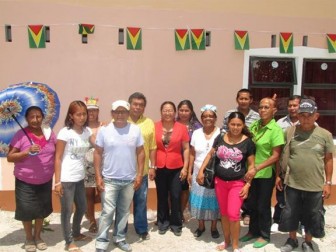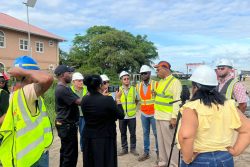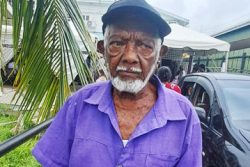Minister of Amerindian Affairs Pauline Sukhai, Chairperson of the National Toshaos Council Yvonne Pearson and a team noted that Isseneru, Upper Mazaruni River, has developed greatly, following a recent visit to the community.
The team visited the Region Seven riverain community to commission a recently built $25M guest house, a press release from the Government Information Agency (GINA) said. The two-storey concrete and wooden building boasts seven rooms, one master suite, a kitchen, and dining and living room areas. It also has indoor plumbing and runs on solar power and a back-up power supply.
Prior to the ceremony, Sukhai told residents that many Amerindian communities are becoming more self-sufficient as a result of initiatives realised under the People’s Progressive Party/ Civic administration. “The changing landscape, she noted is testimony to Guy-ana’s development through access to more educational and health facilities, the availability of potable water, road infrastructure and social services,” GINA said.

The minister said economic development is fast becoming the sector which is ticking at the village level especially in Isseneru which has already taken steps to boost employment. “The current generation of Amerindians has taken a different approach to life, an approach that says we are maturing as a people, we are becoming responsible for our development and that we are ready and willing to take development into our hands,” Sukhai said. She also noted that the opening of the guest house is very significant to the village’s history and will be “even more significant as the village takes bolder steps towards harnessing its development.”
Celebrating their heritage
Regarding Amerindian Heritage Month, Sukhai informed the community of the grand launch in Georgetown which surpassed the attendance and expectations of the previous years, with all ethnic groups present. She then urged residents to continue to teach their children their native tongue to make them more receptive to maintaining their culture.
The minister also underscored the importance of education as crucial to cultural and personal development. “Without an education it would be more difficult to [realising] our dreams and vision for a better life for the present and future generations of Amerindians,” she said. According to GINA, more than 90 per cent of teachers in schools in hinterland regions are from their local communities and over 50 per cent of the hinterland students who complete their primary education can access secondary and tertiary education.
Sukhai also informed the meeting that initiatives such as the US$1M education learning channel that will soon be aired countrywide and the One Laptop Per Family Programme will significantly boost their lives. “Government will be equipping each village with a bank of computers and we expect, not payments for this intervention but, that the population; children, young people and mature adults will make efforts to be computer literate,” she said.
In addition, residents will also benefit from government’s Hinterland Electrification Programme that will see 11,000 households benefiting from solar energy. “The 65-watt home systems are expected to arrive in Guyana before the end of September and persons from different regions have already begun training to install and maintain the systems,” the minister said. Region Seven communities are set to benefit and the training will start there shortly.
GINA said in 2010 the Amerindian Affairs Ministry was tasked with distributing 1,000, solar panels to 23 communities. “Through the Un-served Areas Electrification Programme, 574 solar panels were distributed to 16 Amerindian communities in Regions One, Two and Nine,” it stated.





